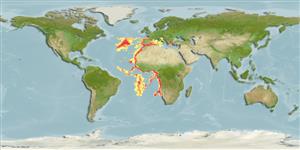Common names from other countries
Classification / Names / Names
Populärnamn | synonymer | Catalog of Fishes (gen., sp.) | ITIS | CoL | WoRMS
Environment: milieu / climate zone / depth range / distribution range
Ekologi
Pelagiska; djupintervall 0 - 3660 m (Ref. 104052). Subtropical; 45°N - 25°S (Ref. 104052)
Eastern Atlantic, USSR and the Mediterranean.
Length at first maturity / Size / Vikt / Age
Maturity: Lm ? range ? - ? cm Max length : 7.0 cm ML hane/ej könsbestämd; (Ref. 104052); 4.2 cm ML (female)
Maximum total length: 8.4 cm (Ref. 3760). Maximum mantle length 7cm, unsexed (Ref. 2399).
Life cycle and mating behavior
Könsmognad | Reproduktion | Lek | Ägg | Fecundity | Larver
Members of the class Cephalopoda are gonochoric. Male and female adults usually die shortly after spawning and brooding, respectively. Mating behavior: Males perform various displays to attract potential females for copulation. During copulation, male grasp the female and inserts the hectocotylus into the female's mantle cavity where fertilization usually occurs. Life cycle: Embryos hatch into planktonic stage and live for some time before they grow larger and take up a benthic existence as adults.
Nesis, K.N. 1987. (Ref. 2399)
IUCN Red List Status (Ref. 130435)
CITES status (Ref. 108899)
Not Evaluated
Not Evaluated
Human uses
Fiskeri: saknar intresse
| FishSource |
Verktyg
Ytterligare information
Age/SizeTillväxtLength-weightLength-lengthMorfologiLarverAbundans
Internet-källor
Estimates based on models
Vulnerability
Low vulnerability (10 of 100).
